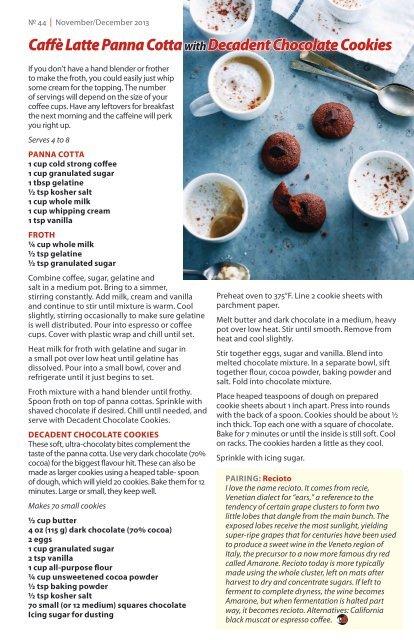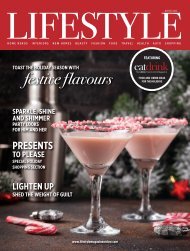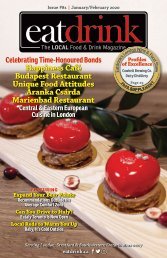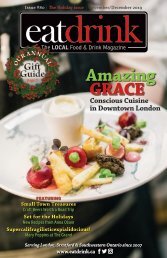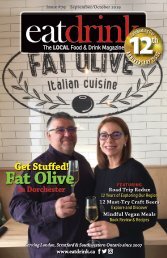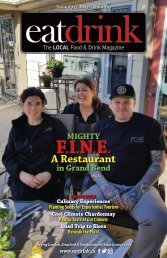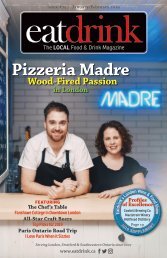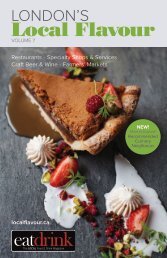Eatdrink #44 November/December 2013
The LOCAL food and drink magazine serving London, Stratford and Southwestern Ontario since 2007.
The LOCAL food and drink magazine serving London, Stratford and Southwestern Ontario since 2007.
You also want an ePaper? Increase the reach of your titles
YUMPU automatically turns print PDFs into web optimized ePapers that Google loves.
№ 44 | <strong>November</strong>/<strong>December</strong> <strong>2013</strong> www.eatdrink.ca 61<br />
Caffè Latte Panna Cotta with Decadent Chocolate Cookies<br />
If you don’t have a hand blender or frother<br />
to make the froth, you could easily just whip<br />
some cream for the topping. The number<br />
of servings will depend on the size of your<br />
coffee cups. Have any leftovers for breakfast<br />
the next morning and the caffeine will perk<br />
you right up.<br />
Serves 4 to 8<br />
pAnna Cotta<br />
1 cup cold strong coffee<br />
1 cup granulated sugar<br />
1 tbsp gelatine<br />
½ tsp kosher salt<br />
1 cup whole milk<br />
1 cup whipping cream<br />
1 tsp vanilla<br />
Froth<br />
¼ cup whole milk<br />
½ tsp gelatine<br />
½ tsp granulated sugar<br />
Combine coffee, sugar, gelatine and<br />
salt in a medium pot. Bring to a simmer,<br />
stirring constantly. Add milk, cream and vanilla<br />
and continue to stir until mixture is warm. Cool<br />
slightly, stirring occasionally to make sure gelatine<br />
is well distributed. Pour into espresso or coffee<br />
cups. Cover with plastic wrap and chill until set.<br />
Heat milk for froth with gelatine and sugar in<br />
a small pot over low heat until gelatine has<br />
dissolved. Pour into a small bowl, cover and<br />
refrigerate until it just begins to set.<br />
Froth mixture with a hand blender until frothy.<br />
Spoon froth on top of panna cottas. Sprinkle with<br />
shaved chocolate if desired. Chill until needed, and<br />
serve with Decadent Chocolate Cookies.<br />
DeCADent ChOCOLAte Cookies<br />
These soft, ultra-chocolaty bites complement the<br />
taste of the panna cotta. Use very dark chocolate (70%<br />
cocoa) for the biggest flavour hit. These can also be<br />
made as larger cookies using a heaped table- spoon<br />
of dough, which will yield 20 cookies. Bake them for 12<br />
minutes. Large or small, they keep well.<br />
Makes 70 small cookies<br />
½ cup butter<br />
4 oz (115 g) dark chocolate (70% cocoa)<br />
2 eggs<br />
1 cup granulated sugar<br />
2 tsp vanilla<br />
1 cup all-purpose flour<br />
¼ cup unsweetened cocoa powder<br />
½ tsp baking powder<br />
½ tsp kosher salt<br />
70 small (or 12 medium) squares chocolate<br />
Icing sugar for dusting<br />
Preheat oven to 375°F. Line 2 cookie sheets with<br />
parchment paper.<br />
Melt butter and dark chocolate in a medium, heavy<br />
pot over low heat. Stir until smooth. Remove from<br />
heat and cool slightly.<br />
Stir together eggs, sugar and vanilla. Blend into<br />
melted chocolate mixture. In a separate bowl, sift<br />
together flour, cocoa powder, baking powder and<br />
salt. Fold into chocolate mixture.<br />
Place heaped teaspoons of dough on prepared<br />
cookie sheets about 1 inch apart. Press into rounds<br />
with the back of a spoon. Cookies should be about ½<br />
inch thick. Top each one with a square of chocolate.<br />
Bake for 7 minutes or until the inside is still soft. Cool<br />
on racks. The cookies harden a little as they cool.<br />
Sprinkle with icing sugar.<br />
PAIrinG: Recioto<br />
I love the name recioto. It comes from recie,<br />
Venetian dialect for “ears,” a reference to the<br />
tendency of certain grape clusters to form two<br />
little lobes that dangle from the main bunch. The<br />
exposed lobes receive the most sunlight, yielding<br />
super-ripe grapes that for centuries have been used<br />
to produce a sweet wine in the Veneto region of<br />
Italy, the precursor to a now more famous dry red<br />
called Amarone. Recioto today is more typically<br />
made using the whole cluster, left on mats after<br />
harvest to dry and concentrate sugars. If left to<br />
ferment to complete dryness, the wine becomes<br />
Amarone, but when fermentation is halted part<br />
way, it becomes recioto. Alternatives: California<br />
black muscat or espresso coffee.


